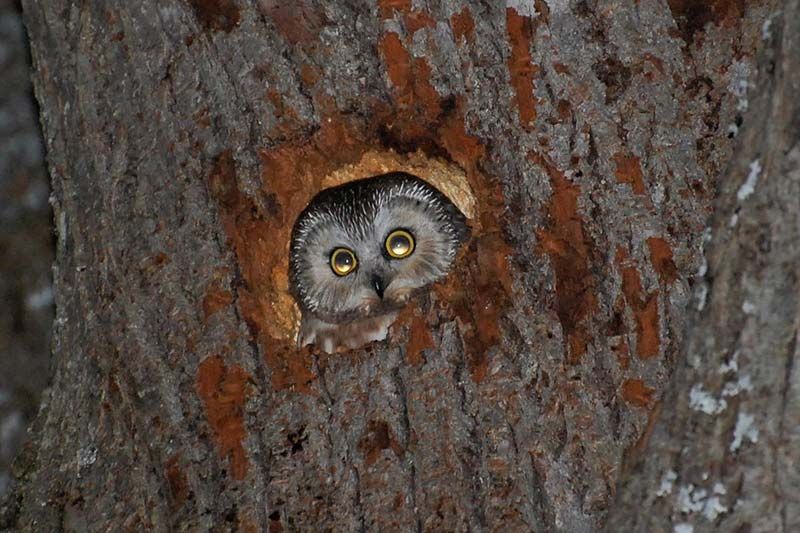Steve Blight | Apr 04, 2018
A reader from South Frontenac sent the Frontenac News this marvellous picture of a small, round face observing the world from the safety of a tree hole. Its huge yellow eyes, narrow hooked bill and disk-shaped face quickly identifies it as an owl, and a bit more detective work narrows the choice down to only one real possibility -- the smallest owl in our area, the Northern Saw-whet Owl.
Saw-whets are not an uncommon bird in our area, but because of its secretive, nocturnal nature, not many people get a chance to see one. This is a pity because they are adorable-looking creatures and watching one would gladden the hearts of many people. In our area they may be heard more than seen – on quiet nights in March and April listen for their sharp, high, repeated too-too-too call. During the day these diminutive owls often roost silently in dense conifers. If you would like to hear a recording of the bird’s call before you go out, visit Cornell University’s excellent All About Birds website and follow the clear instructions to the saw-whet pages.
I personally have seen or heard less than 10 saw-whets during my birding career, with the last two on the same day in February 2018. The first was in a tree at the edge of a stand of scrubby jack pines on Amherst Island. It appeared to be passing the daylight hours roosting quietly about 8 feet off the ground, and within a foot or so of the trunk. Only determined searching by a keen-eyed member of our birding group was able to find this little owl. And while secretive, they aren’t shy. Once spotted, the saw-whet stayed put and watched calmly as birder after birder came by to admire it.
I spotted my second saw-whet the same day as I was on the way home, passing through Crow Lake Village in the early evening. A little brown fluff ball was sitting upright in the middle of the road, and I stopped to avoid hitting it. The fluff ball turned its wide-eyed gaze towards me, we looked at each other for about 10 seconds, then it flew off. Two saw-whets in one day made for a very satisfying outing.
Northern Saw-whet Owls are quite small, able to fit comfortably in a pint glass. They breed in a wide variety of forests across North America, showing a preference for mature coniferous woods. Nests are normally placed in tree cavities excavated by woodpeckers, but they will readily take to next boxes. During the breeding season, females do all of the incubation and brooding, while the male does the hunting. When the youngest nestling is about three weeks old, the female leaves the nest to roost elsewhere. The male continues bringing food, which the older nestlings may help feed to their younger siblings. Saw-whets prey mainly on small mammals such as mice and voles, but small birds and even insects may make up parts of their diet. Saw-whets in turn are preyed upon by larger birds of prey, including hawks and other owls.
Saw-whet migration is complex – some birds migrate south, particularly young birds, while others often stay put in winter. However, when food supplies drop, more birds seem to migrate to areas of greater food abundance. Estimates put the North American population of saw-whets at about 2 million birds, with some 46% spending part of the year in Canada. Populations seem to be secure, but declines in some areas and increases in others make it difficult to be certain about its conservation status. The oldest Saw-whet Owl on record was 9 years 5 months old.
Another good way to spot a saw-whet is to pay attention to the behaviour of small flocks of songbirds including chickadees, nuthatches and kinglets. When they discover a roosting saw-whet, they’re likely to make a lot of noise, calling and flying excitedly at the owl – a behaviour known as “mobbing” – until the owl moves on. The same kind of behaviour can be seen, although on an obviously larger scale, by groups of blackbirds mobbing a crow or raven, or indeed a group of crows mobbing a Bald Eagle. It turns out no-one really wants to be eaten by a bigger bird!
More Stories
- September Closures for Northbrook And Sharbot Lake Beer Stores
- This "Doc Is Not In Anymore" After 54 Years
- Mazinaw Lake Swim Program Only Getting Stronger After 53 Years
- "Jack of Diamonds, Jack of Diamonds" but No Ace Of Spades Yet
- Sydenham Legion Presents ATV to Canada Day Raffle Winner
- Bathing in Blue Mindfulness: An Otter Lake Journey in Frontenac Park
- Central Frontenac Buys Used Pumper At Special Meeting
- 4th Annual Sharbot Lake Beach Bash
- Frontenac ATV Club Rallies For A Community Cause
- Harrowsmith Shadowdale Blooms: Kindness In Full Colour

